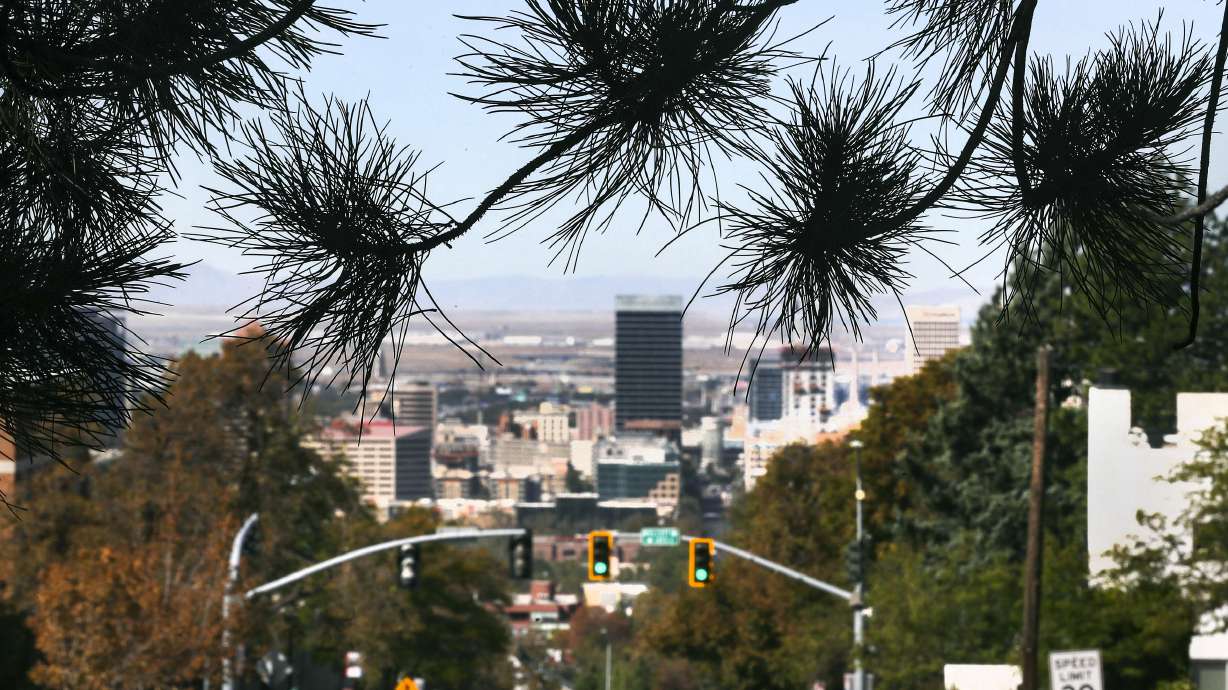Estimated read time: 4-5 minutes
This archived news story is available only for your personal, non-commercial use. Information in the story may be outdated or superseded by additional information. Reading or replaying the story in its archived form does not constitute a republication of the story.
SALT LAKE CITY — University of Utah researchers are using evergreens on campus to measure air quality — yes fine particulate pollution on trees — in a cost-effective way to give a picture of where vehicle exhaust and other pollutants accumulate.
“Wherever you have a tree you have a data point,” said Grant Rea-Downing, a doctoral student in geology and geophysics.
“A tree doesn’t cost $250 to deploy. We’ll be able to map particulate matter distributions at a very high resolution for very little cost.”
The findings were published in GeoHealth and represent a first-of-its-kind study.
“We’re not the first to explore the magnetism of pine needles to monitor air quality,” associate professor Pete Lippert said, “but no one had tried this to study winter inversions in the basins of the American West.”
Lippert and fellow graduate students Courtney Wagner and Brendon Quirk are all geoscientists in the Department of Geology and Geophysics whose regular research is on a much different scale than pine needles.
“Day to day,” Lippert says, “we move mountains and close ocean basins by using the magnetism of rocks to figure out the geography of former continents.”
Lippert introduced Rea-Downing, Wagner and Quirk to research done in the United Kingdom that measured the magnetism of deciduous leaves to analyze air quality.
“I knew the students would kind of have their minds blown by what the study showed, and what the implications of the findings were,” Lippert said.

Air pollution comes from a variety of sources such as vehicle exhaust, buildings and windblown dust.
“That’s stuff in the air,” he said, “and it’s got to come out sometime.”
Researchers collected pine needles from a trio of evergreens planted on campus at varying elevations and in different proximity to busy North Campus Drive.
The fourth tree where samples were collected was near the Olpin Student Union building, away from traffic. The sampling periods included once in June of 2017 during relatively good air quality and again in December 2017 — during some of that winter’s worst air quality.
Wagner, wearing a pollution mask, collected the December samples in what she described as a “freezing death fog” during a temperature inversion trapping ugly, yellowish fog and frost on the pine needles.
Once back in the lab, the team cut the needles into short segments using ceramic scissors to avoid any metals contamination and put them in the magnetometers.
One of their experiments revealed that the “magnetization” of the December needles was nearly three times higher than the June needles. Another experiment, conducted at low temperatures, suggested the iron-bearing particles deposited during the inversion are extremely small — some as small as 1/5,000th the width of a human hair.
The team also examined the needles under an electron microscope and confirmed that the December needles were significantly dirtier. The concentration, size and composition of the particles have all been linked the health risks of air pollution.

Some of the elements contained in the fine particulate pollution were associated with fossil fuel combustion.
“And those concentrations, no surprise, are highest near the roadside,” Lippert said.
The researcher added that a great reveal of this local study is how closely it dovetailed the results of previous studies done in the United Kingdom.
“I was surprised at how well our results were consistent with their results in the wintertime,” he said. “We can think of magnetism as a proxy or a substitute for how much particulate matter is on the trees.”
The composition of iron, as well as the size of the particulate matter, helps to determine its source, he said.
The research is transitioning to another phase — one that ropes in atmospheric scientist Gannet Hallar and chemical engineer Kerry Kelly to find more answers.
“Although this study answered some questions, it also raised a lot more questions we need to look into in more detail,” Lippert said.
They developed a new kind of passive air monitor — a 3D printed, artificial pine branch with needles to catch particulates. The artificial needles are installed alongside natural needles and will serve as a platform to more clearly understand how and when particles settle on evergreen needles.
“If we get a strong rain we can go and collect before and after that rain and see if this signal is just being washed away every time you have a rain event,” Rea-Downing said. “Or are the biological needles actually absorbing material and actually holding onto that signal for longer than the synthetic needles?”
By bringing in those laboratories for additional analysis, Lippert said researchers will be able to drill down for more answers as to the distribution, and the lasting power, of pollution that deposits on trees.
With every tree as a potential data point, pine needle analysis could give a more comprehensive insight into mapping the air pollution in more detail and in inexpensive and simple ways, researchers believe.
“We have a lot of trees out on the landscape already,” Lippert said. “This is easily exportable to any community. It allows us to do more with less, or that’s our hope.”










